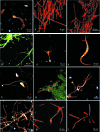In situ detection of freshwater fungi in an alpine stream by new taxon-specific fluorescence in situ hybridization probes
- PMID: 18776035
- PMCID: PMC2570288
- DOI: 10.1128/AEM.00815-08
In situ detection of freshwater fungi in an alpine stream by new taxon-specific fluorescence in situ hybridization probes
Abstract
New rRNA-targeting oligonucleotide probes permitted the fluorescence in situ hybridization (FISH) identification of freshwater fungi in an Austrian second-order alpine stream. Based on computer-assisted comparative sequence analysis, nine taxon-specific probes were designed and evaluated by whole-fungus hybridizations. Oligonucleotide probe MY1574, specific for a wide range of Eumycota, and the genus (Tetracladium)-specific probe TCLAD1395, as well as the species-specific probes ALacumi1698 (Alatospora acuminata), TRIang322 (Tricladium angulatum), and Alongi340 (Anguillospora longissima), are targeted against 18S rRNA, whereas probes TmarchB10, TmarchC1_1, TmarchC1_2, and AlongiB16 are targeted against the 28S rRNA of Tetracladium marchalianum and Anguillospora longissima, respectively. After 2 weeks and 3 months of exposure of polyethylene slides in the stream, attached germinating conidia and growing hyphae of freshwater fungi were accessible for FISH. Growing hyphae and germinating conidia on leaves and in membrane cages were also visualized by the new FISH probes.
Figures

References
-
- Arsuffi, T. I., and K. Suberkropp. 1989. Selective feeding by shredders on leaf-colonizing stream fungi: comparison on macroinvertebrate taxa. Oecologia 79:30-37. - PubMed
-
- Bärlocher, F. 1982. Conidium production from leaves and needles in four streams. Can. J. Bot. 60:1487-1494.
-
- Bärlocher, F. 1992. Community organisation, p. 38-69. In F. Bärlocher (ed.), The ecology of aquatic hyphomycetes. Springer Verlag, Berlin, Germany.
Publication types
MeSH terms
Substances
Associated data
- Actions
- Actions
- Actions
- Actions
- Actions
- Actions
- Actions
- Actions
- Actions
- Actions
- Actions
- Actions
- Actions
- Actions
- Actions
- Actions
- Actions
- Actions
- Actions
- Actions
- Actions
- Actions
- Actions
- Actions
- Actions
- Actions
- Actions
- Actions
- Actions
- Actions
- Actions
- Actions
- Actions
- Actions
- Actions
LinkOut - more resources
Full Text Sources
Medical
Molecular Biology Databases

